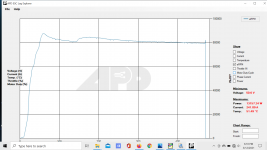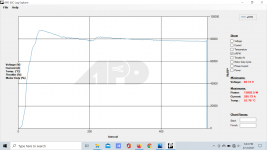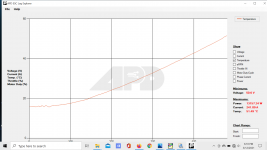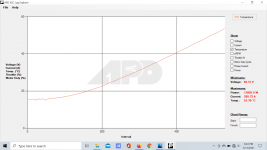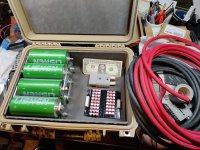I started doing research again the hard way (googling, reading technical papers, etc) when I realized - We have a forum! So here's my question for you all - as you probably know, I'm switching over to an LTO battery pack. That should give me more power to deliver to my ESC/motor combination. Right now, I'm just under 14 kW going down track according to my ESC datalogs. The measured power going into the ESC is a bit more, but I'm going to go by what the ESC is telling me rather than my cheap chineseum meters.
My motor is rated for a 15 kW peak (9 kW continuous - but I'm only concerned about peak because I'm interested primarily in drag strip performance). How can I tell when my motor has no more power to offer? What should I be looking for in my datalogs? With this new pack, fully charged at "resting" voltage, I should see about 73 volts. But my ESC is rated at a max of 70 volts (or 68, according to the people who made it; I need clarification on that). Either way, voltage drop under power should be significantly less than I was see with my LiPo pack (67.2 fully charged, and about 52 going down track (on the meters); 50 if you go by the ESC data). I was thinking of starting our next dyno session at either 64 or 66 volts, with the idea that it probably won't drop further than about 54 volts.
The question - how do I know if I can keep turning up the voltage? I know at some point the motor will get hot, but I'd like to know what to look for in the data logs. I'm open to all ideas and suggestion (except, maybe, the classic, "keep going until it catches fire, explodes or melts, and then turn it down a couple of volts...")
Thoughts?
My motor is rated for a 15 kW peak (9 kW continuous - but I'm only concerned about peak because I'm interested primarily in drag strip performance). How can I tell when my motor has no more power to offer? What should I be looking for in my datalogs? With this new pack, fully charged at "resting" voltage, I should see about 73 volts. But my ESC is rated at a max of 70 volts (or 68, according to the people who made it; I need clarification on that). Either way, voltage drop under power should be significantly less than I was see with my LiPo pack (67.2 fully charged, and about 52 going down track (on the meters); 50 if you go by the ESC data). I was thinking of starting our next dyno session at either 64 or 66 volts, with the idea that it probably won't drop further than about 54 volts.
The question - how do I know if I can keep turning up the voltage? I know at some point the motor will get hot, but I'd like to know what to look for in the data logs. I'm open to all ideas and suggestion (except, maybe, the classic, "keep going until it catches fire, explodes or melts, and then turn it down a couple of volts...")
Thoughts?

